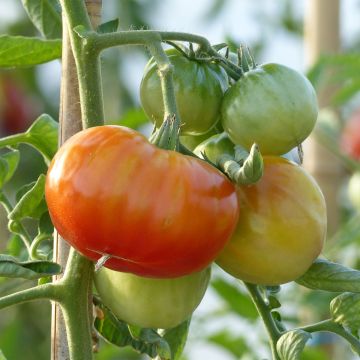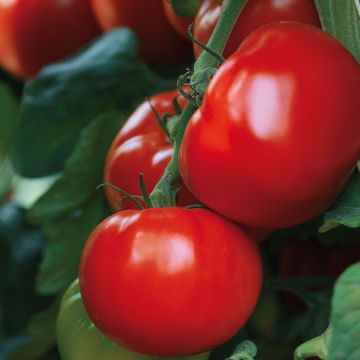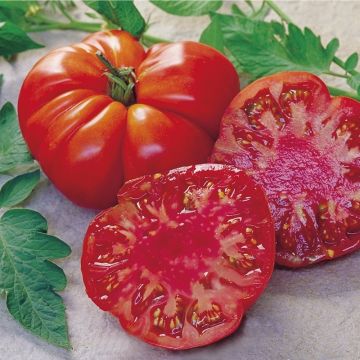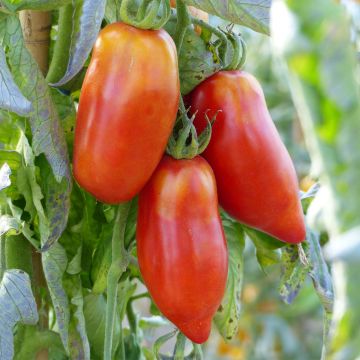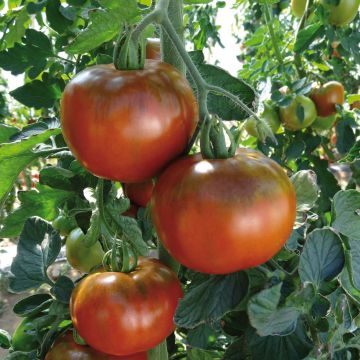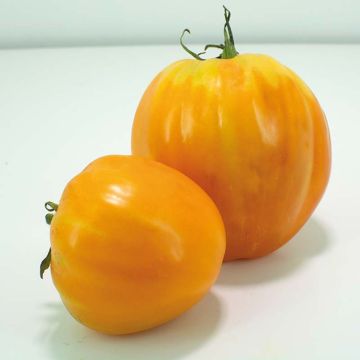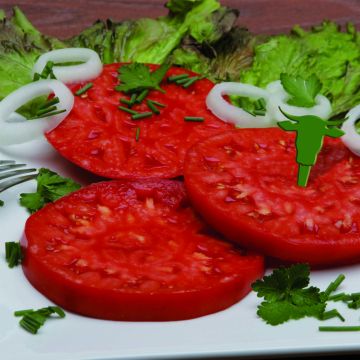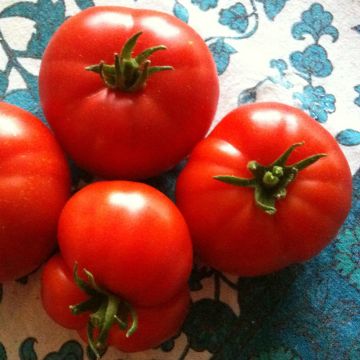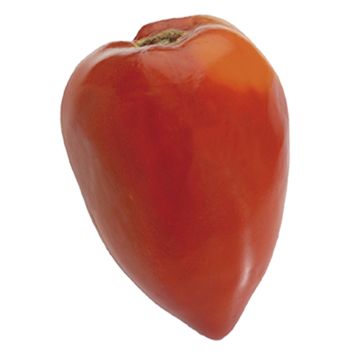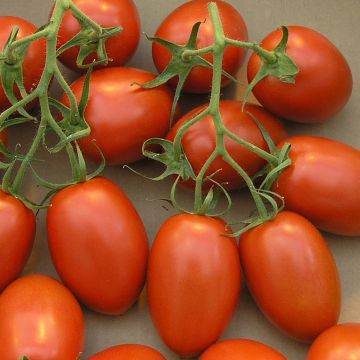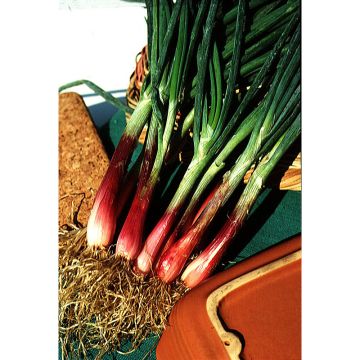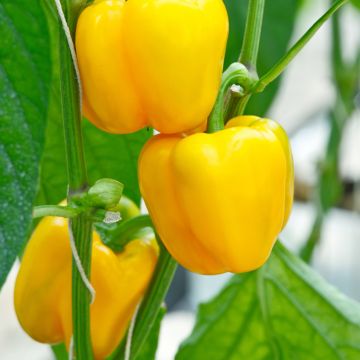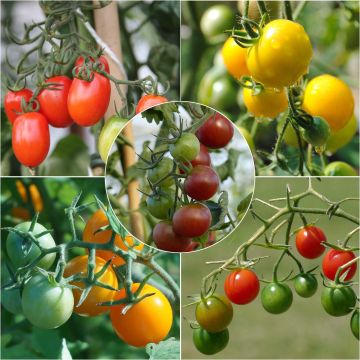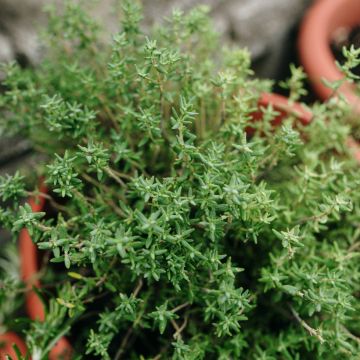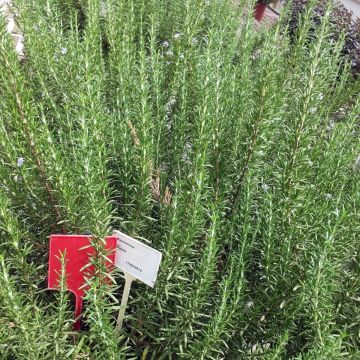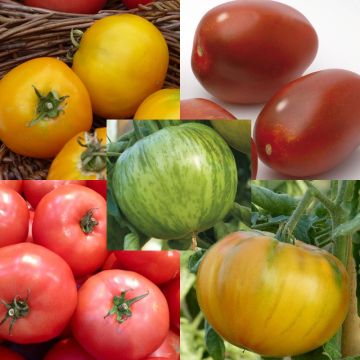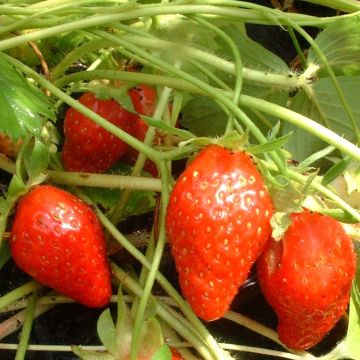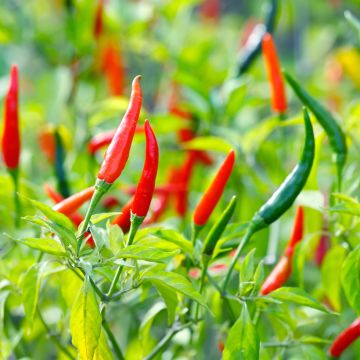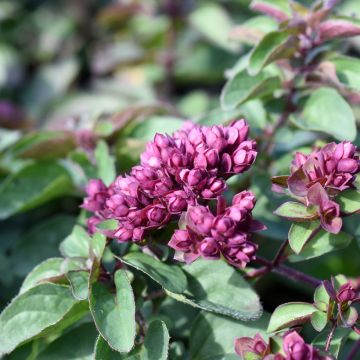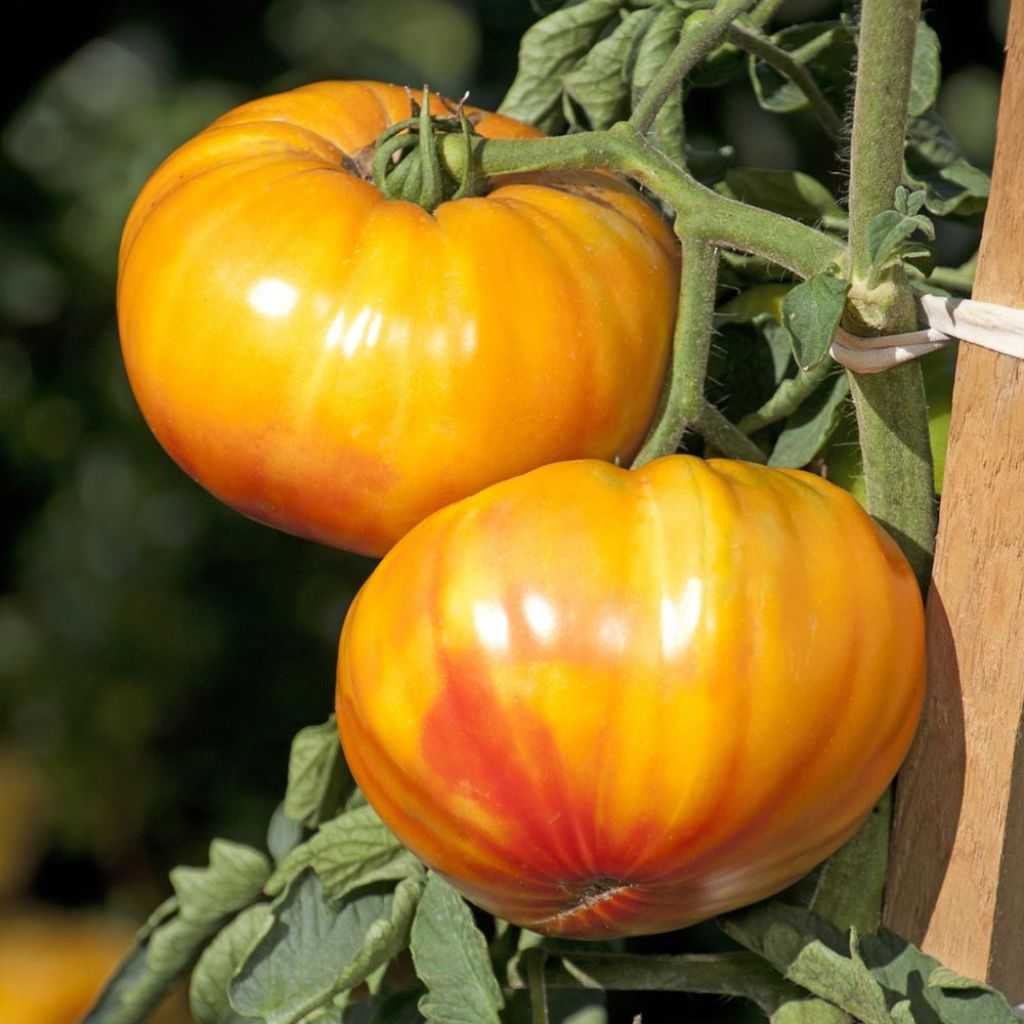

Tomato Buffalo Sun
Tomato Buffalo Sun
Solanum lycopersicum Buffalo Sun
Tomato
This item cannot be shipped to the selected country
Delivery charge from €5.90
Delivery charge from €5.90
More information
Schedule delivery date,
and select date in basket
This plant carries a 6 months recovery warranty
More information
We guarantee the quality of our plants for a full growing cycle, and will replace at our expense any plant that fails to recover under normal climatic and planting conditions.
From €5.90 for pickup delivery and €6.90 for home delivery
Express home delivery from €8.90.
From €5.90 for pickup delivery and €6.90 for home delivery
Express home delivery from €8.90.
Description
The Buffalosun Tomato is a variant of the famous 'Buffalosteak', from which it differs by colour. This variety produces huge, flattened, round and ribbed, fleshy, tasty fruits, with dense and firm flesh, weighing up to 800 g and beautifully coloured red-orange-gold. It is versatile and can be enjoyed raw, used to prepare coulis, juices or soups and stuffed tomatoes, as its flavour is rich and aromatic. The plants are very vigorous and you will need to stake them quickly so as not to see them bend under the weight of their fruits. Plant plug plants from April to June after the last frost when the plants have reached about fifteen cm. The 'Buffalosun Tomato' is harvested from July to October.
The tomato is native to South America and Central America. Several varieties were cultivated by the Incas long before the arrival of the Conquistadors. We are always amazed by the genetic richness of this solanaceous plant. The term 'tomato' comes from the Inca Tomatl and refers both to the plant and the fruit produced by the plant. There are fruits of all colours, except perhaps blue, and all shapes and sizes.
The tomato is one of the many foods that came to us from the New World, like beans, corn, squash, potatoes, and chilli. It took a notably longer time to reach our taste buds; it was long cultivated for its aesthetic and medicinal qualities. It was thought to be toxic because it resembled the fruit of the Mandrake, another solanaceous plant. It only became a regular on our tables from the beginning of the 20th century.
The tomato plant is a herbaceous perennial in tropical climates, cultivated as an annual in our latitudes. It turns woody over time and produces small, insignificant yellow flower clusters that will transform into fruits.
Its fruit is very attractive and pleasantly colours the vegetable garden and it has many nutritional benefits. It is low in calories like most vegetables, rich in water and contains lycopene, a powerful antioxidant. And the longer the tomato is cooked, the more it releases this precious nutrient and makes it available to the body. It is also distinguished by its richness in vitamin C (especially when raw), pro-vitamin A, and trace elements.
Harvesting: Buffalosun is a medium early variety that can bear fruit from July-August to October depending on the planting date and the conditions (under cover or in the open air). There is no foolproof trick to determine when a tomato has reached full ripeness. Harvest when it is completely the colour it should be and its texture remains firm but shows slight softening. For better preservation, you should pick the fruit with its stalk.
Storage: Tomatoes should be stored at an optimal temperature of 10-15°C (50-59°F). They can be kept well for a few days in the vegetable compartment of your refrigerator or spread out in the open air. However, refrigeration alters the taste qualities of the fruit. To keep them longer, consider methods such as tomato confits, sun-dried tomatoes, sauces, frozen fruits, preserves, jams, or juices. We love to confit them because it's so simple and delicious: cut your tomatoes in half and collect the juice. Place your tomato halves face up on the baking sheet of your oven. Season with salt, pepper, and sugar, then bake at a very low temperature for at least an hour. Remove your tomatoes and consume them immediately, or store them in a glass jar and cover them with olive oil.
Gardener's tip: It is a good idea to grow several varieties of tomatoes each year to minimize the risks of complete crop loss due to climatic or specific pathology. To counter the phenomenon of 'tomato blossom end rot' - not a disease but a calcium deficiency - spray a comfrey maceration rich in calcium on your plants.
Report an error about the product description
Harvest
Plant habit
Foliage
Other Large tomato plants
Planting and care
Tomato plants are easy to grow. Sunlight and warmth are crucial for the success of this crop. Tomatoes thrive in rich, well-drained, and deeply cultivated soil. A few months before planting, add mature compost after loosening the soil. If your soil is heavy, add some sand at the time of planting.
Allow the plug plants to grow on by transplanting them into 8 to 10.5 cm (3 to 4in) pots filled with potting soil. Place them in a sunny and heated location, ensuring that the temperature never drops below 12-14°C (53.6-57.2°F), as this can cause the foliage to turn yellow and stunt the plant's growth. Once the plants reach about 15 cm (6in) high, transplant them into the ground if the outdoor temperatures allow.
Planting in the ground should be done once the risk of frost has passed, typically after mid-May. Choose a sunny and sheltered location. Space the plants 50 cm (20in) apart in rows with 70 cm (0 and 28in) between rows if pruning, or 1 m (0 or 3ft) in all directions for unpruned plants. Dig a hole (3 times the size of the plug) and add some well-rotted compost to the bottom of the hole. Place your plant, which can be buried up to the first leaves, then backfill. Firm the soil, create a basin around the base, and water generously. Be careful not to wet the leaves, to protect your plants from fungal diseases.
Install stakes (soon after planting to avoid damaging the roots), mulch around the base of the plants and water regularly, as irregular watering can lead to calcium deficiency, resulting in a condition known as "blossom end rot."
Tomatoes, like potatoes, are susceptible to late blight, a fungal disease caused by Phytophthora infestans. Late blight develops in warm and humid weather. Small spots appear, white on the undersides of the leaves and green-grey on top. To reduce the risk, space the plants adequately and avoid watering the foliage. Practice crop rotation, wait 4 years before planting any Solanaceae family plants in the same location and do not plant them in neighbouring rows. If necessary, spray with Bordeaux mixture or preparations such as horsetail decoction or garlic infusion.
You can grow tomato plants in pots by choosing varieties with small fruits and placing the pot in a sunny location.
Cultivation
Care
Intended location
-
, onOrder confirmed
Reply from on Promesse de fleurs
Vegetable plants
Haven't found what you were looking for?
Hardiness is the lowest winter temperature a plant can endure without suffering serious damage or even dying. However, hardiness is affected by location (a sheltered area, such as a patio), protection (winter cover) and soil type (hardiness is improved by well-drained soil).

Photo Sharing Terms & Conditions
In order to encourage gardeners to interact and share their experiences, Promesse de fleurs offers various media enabling content to be uploaded onto its Site - in particular via the ‘Photo sharing’ module.
The User agrees to refrain from:
- Posting any content that is illegal, prejudicial, insulting, racist, inciteful to hatred, revisionist, contrary to public decency, that infringes on privacy or on the privacy rights of third parties, in particular the publicity rights of persons and goods, intellectual property rights, or the right to privacy.
- Submitting content on behalf of a third party;
- Impersonate the identity of a third party and/or publish any personal information about a third party;
In general, the User undertakes to refrain from any unethical behaviour.
All Content (in particular text, comments, files, images, photos, videos, creative works, etc.), which may be subject to property or intellectual property rights, image or other private rights, shall remain the property of the User, subject to the limited rights granted by the terms of the licence granted by Promesse de fleurs as stated below. Users are at liberty to publish or not to publish such Content on the Site, notably via the ‘Photo Sharing’ facility, and accept that this Content shall be made public and freely accessible, notably on the Internet.
Users further acknowledge, undertake to have ,and guarantee that they hold all necessary rights and permissions to publish such material on the Site, in particular with regard to the legislation in force pertaining to any privacy, property, intellectual property, image, or contractual rights, or rights of any other nature. By publishing such Content on the Site, Users acknowledge accepting full liability as publishers of the Content within the meaning of the law, and grant Promesse de fleurs, free of charge, an inclusive, worldwide licence for the said Content for the entire duration of its publication, including all reproduction, representation, up/downloading, displaying, performing, transmission, and storage rights.
Users also grant permission for their name to be linked to the Content and accept that this link may not always be made available.
By engaging in posting material, Users consent to their Content becoming automatically accessible on the Internet, in particular on other sites and/or blogs and/or web pages of the Promesse de fleurs site, including in particular social pages and the Promesse de fleurs catalogue.
Users may secure the removal of entrusted content free of charge by issuing a simple request via our contact form.
The flowering period indicated on our website applies to countries and regions located in USDA zone 8 (France, the United Kingdom, Ireland, the Netherlands, etc.)
It will vary according to where you live:
- In zones 9 to 10 (Italy, Spain, Greece, etc.), flowering will occur about 2 to 4 weeks earlier.
- In zones 6 to 7 (Germany, Poland, Slovenia, and lower mountainous regions), flowering will be delayed by 2 to 3 weeks.
- In zone 5 (Central Europe, Scandinavia), blooming will be delayed by 3 to 5 weeks.
In temperate climates, pruning of spring-flowering shrubs (forsythia, spireas, etc.) should be done just after flowering.
Pruning of summer-flowering shrubs (Indian Lilac, Perovskia, etc.) can be done in winter or spring.
In cold regions as well as with frost-sensitive plants, avoid pruning too early when severe frosts may still occur.
The planting period indicated on our website applies to countries and regions located in USDA zone 8 (France, United Kingdom, Ireland, Netherlands).
It will vary according to where you live:
- In Mediterranean zones (Marseille, Madrid, Milan, etc.), autumn and winter are the best planting periods.
- In continental zones (Strasbourg, Munich, Vienna, etc.), delay planting by 2 to 3 weeks in spring and bring it forward by 2 to 4 weeks in autumn.
- In mountainous regions (the Alps, Pyrenees, Carpathians, etc.), it is best to plant in late spring (May-June) or late summer (August-September).
The harvesting period indicated on our website applies to countries and regions in USDA zone 8 (France, England, Ireland, the Netherlands).
In colder areas (Scandinavia, Poland, Austria...) fruit and vegetable harvests are likely to be delayed by 3-4 weeks.
In warmer areas (Italy, Spain, Greece, etc.), harvesting will probably take place earlier, depending on weather conditions.
The sowing periods indicated on our website apply to countries and regions within USDA Zone 8 (France, UK, Ireland, Netherlands).
In colder areas (Scandinavia, Poland, Austria...), delay any outdoor sowing by 3-4 weeks, or sow under glass.
In warmer climes (Italy, Spain, Greece, etc.), bring outdoor sowing forward by a few weeks.

































